Comparative Analysis of Sydney LEP 2012 and Melbourne Planning Scheme
VerifiedAdded on 2023/06/04
|27
|5262
|418
Report
AI Summary
This report provides a comparative analysis of Sydney's Local Environment Plan (LEP) 2012 and Melbourne's Planning Scheme, focusing on how land use controls are used to implement state and local environmental planning policies. It begins with an introduction to the planning and assessment systems in New South Wales and Victoria, highlighting the differences between NSW's LEPs and Victoria's planning schemes. The report then delves into a comparative analysis of the aims and objectives, structure and layout, land use categorization, key policy issues addressed (including housing, sustainable growth, transport, and heritage conservation), development control mechanisms, and relationships with external state policies of both planning instruments. The analysis reveals differences in approach, with Sydney's LEP emphasizing micro-level growth and Melbourne's Planning Scheme adopting a broader, more strategic vision. The report concludes by summarizing the key differences and similarities between the two planning systems.
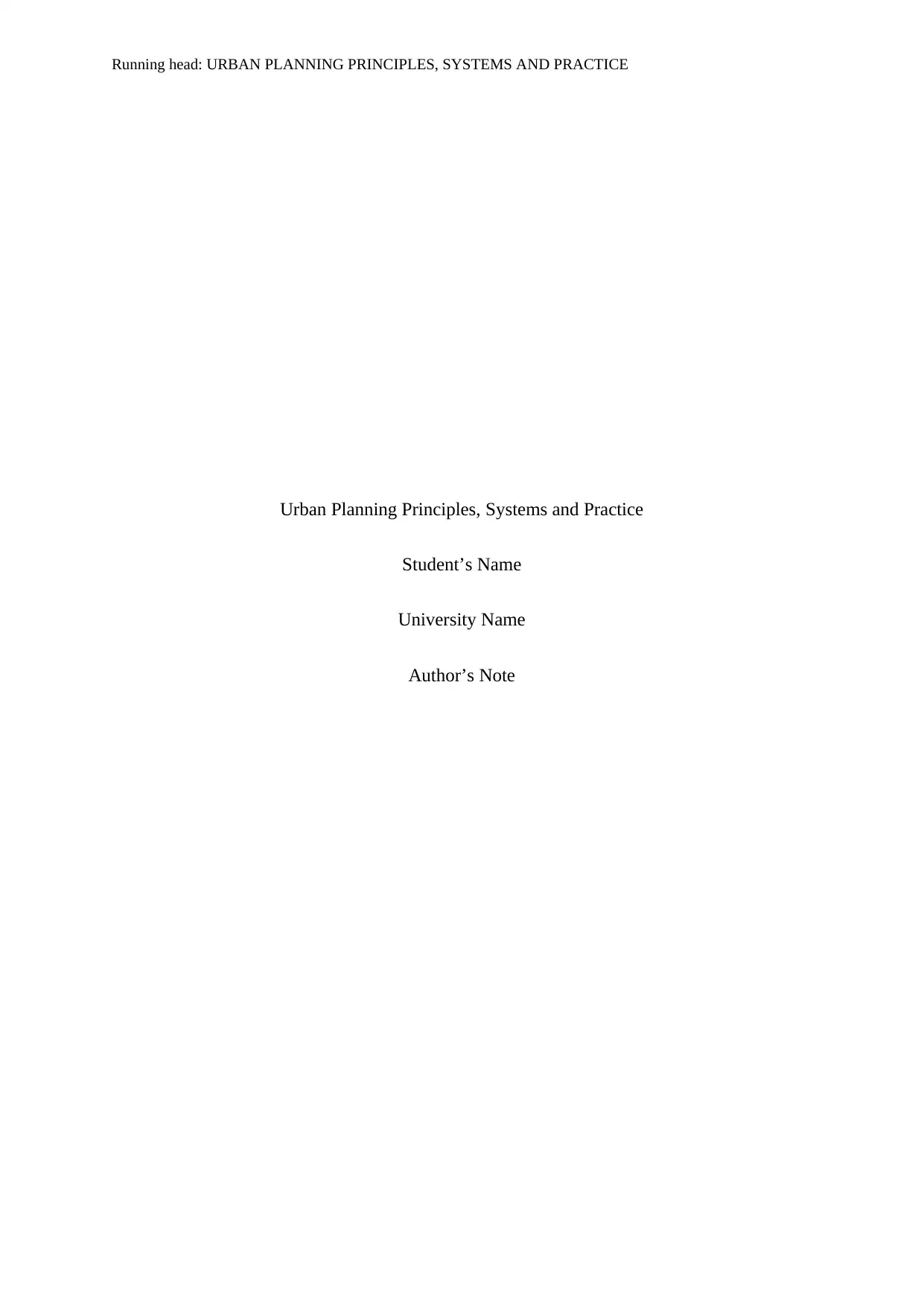
Running head: URBAN PLANNING PRINCIPLES, SYSTEMS AND PRACTICE
Urban Planning Principles, Systems and Practice
Student’s Name
University Name
Author’s Note
Urban Planning Principles, Systems and Practice
Student’s Name
University Name
Author’s Note
Paraphrase This Document
Need a fresh take? Get an instant paraphrase of this document with our AI Paraphraser
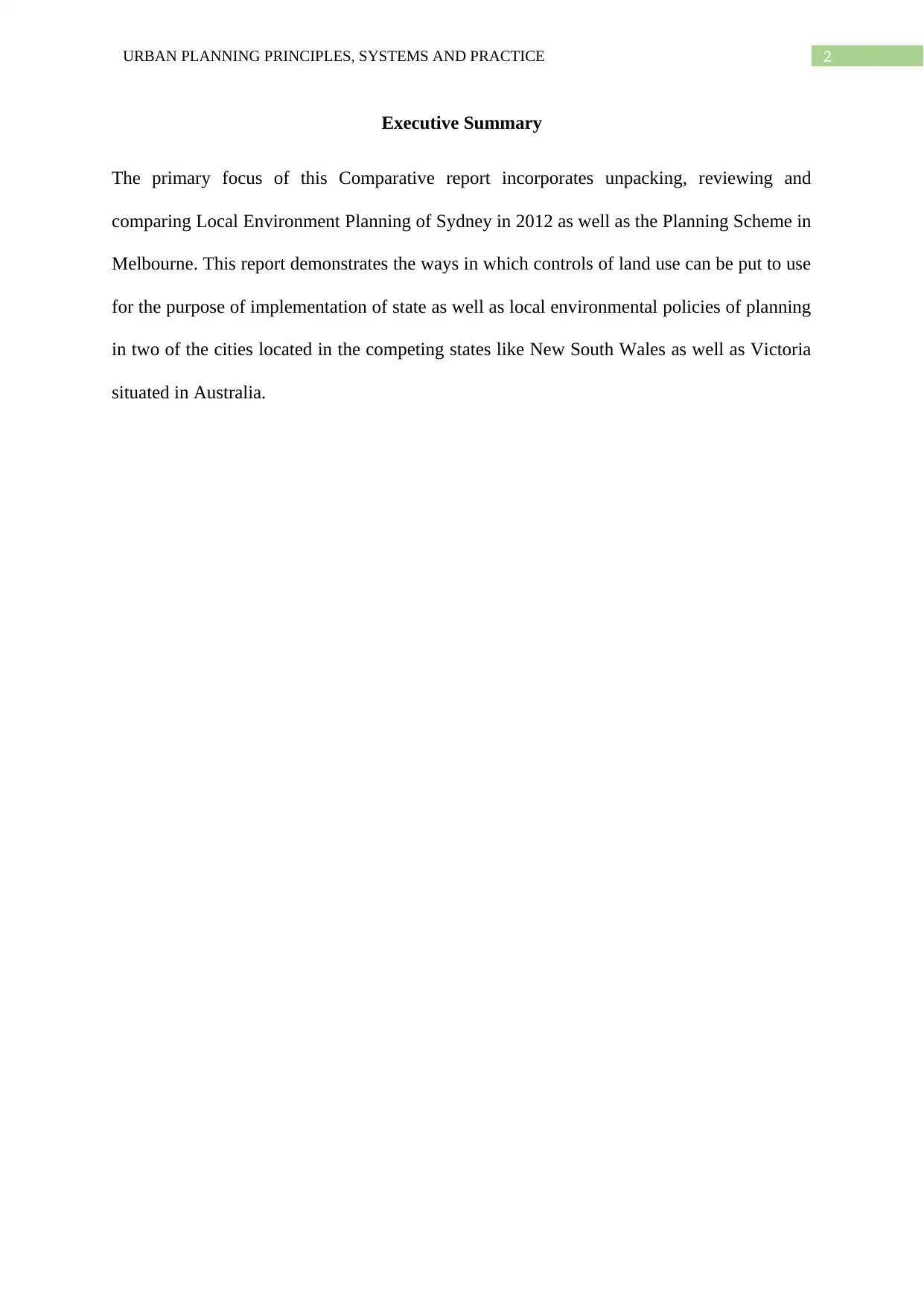
2URBAN PLANNING PRINCIPLES, SYSTEMS AND PRACTICE
Executive Summary
The primary focus of this Comparative report incorporates unpacking, reviewing and
comparing Local Environment Planning of Sydney in 2012 as well as the Planning Scheme in
Melbourne. This report demonstrates the ways in which controls of land use can be put to use
for the purpose of implementation of state as well as local environmental policies of planning
in two of the cities located in the competing states like New South Wales as well as Victoria
situated in Australia.
Executive Summary
The primary focus of this Comparative report incorporates unpacking, reviewing and
comparing Local Environment Planning of Sydney in 2012 as well as the Planning Scheme in
Melbourne. This report demonstrates the ways in which controls of land use can be put to use
for the purpose of implementation of state as well as local environmental policies of planning
in two of the cities located in the competing states like New South Wales as well as Victoria
situated in Australia.
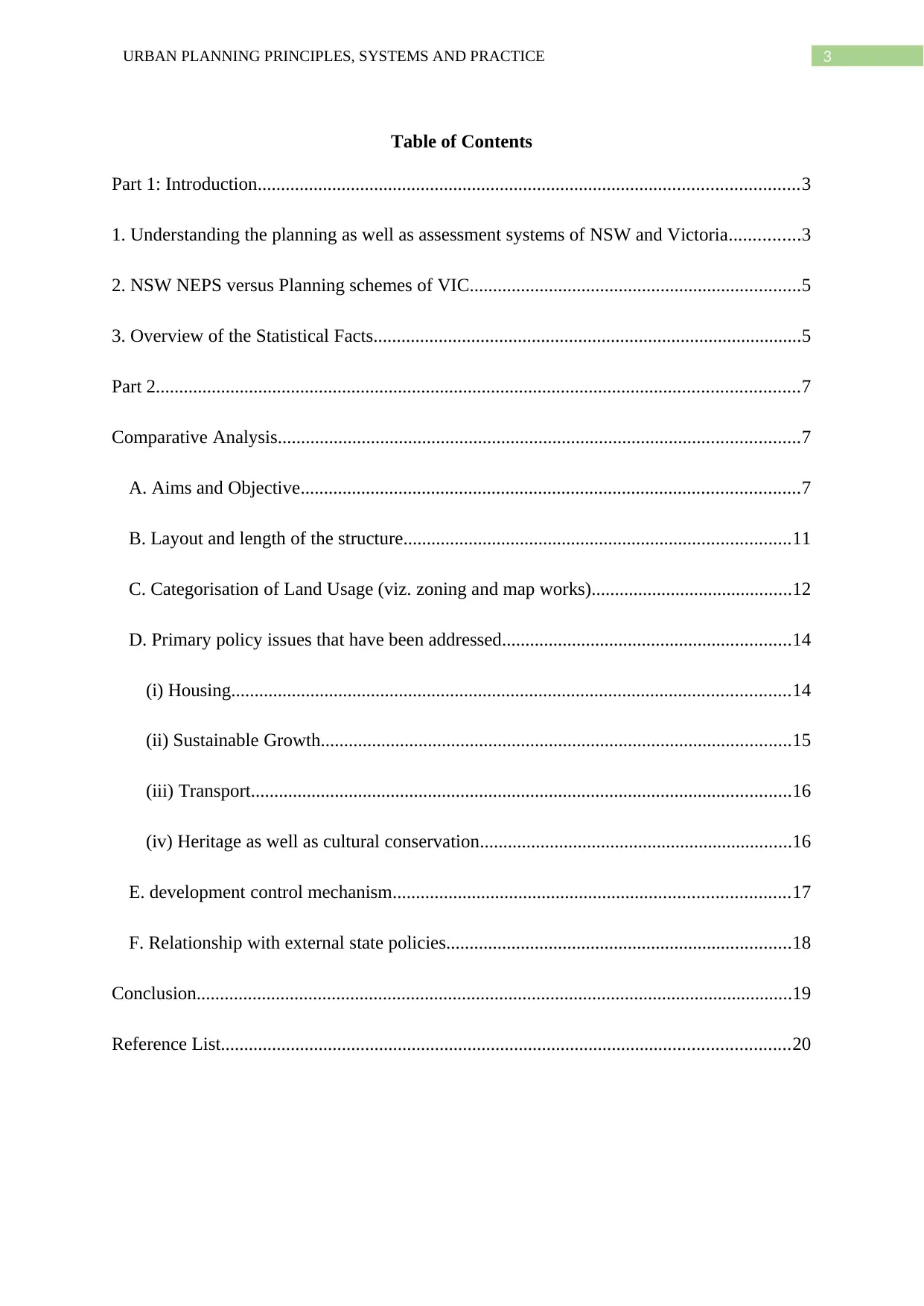
3URBAN PLANNING PRINCIPLES, SYSTEMS AND PRACTICE
Table of Contents
Part 1: Introduction....................................................................................................................3
1. Understanding the planning as well as assessment systems of NSW and Victoria...............3
2. NSW NEPS versus Planning schemes of VIC.......................................................................5
3. Overview of the Statistical Facts............................................................................................5
Part 2..........................................................................................................................................7
Comparative Analysis................................................................................................................7
A. Aims and Objective...........................................................................................................7
B. Layout and length of the structure...................................................................................11
C. Categorisation of Land Usage (viz. zoning and map works)...........................................12
D. Primary policy issues that have been addressed..............................................................14
(i) Housing........................................................................................................................14
(ii) Sustainable Growth.....................................................................................................15
(iii) Transport....................................................................................................................16
(iv) Heritage as well as cultural conservation...................................................................16
E. development control mechanism.....................................................................................17
F. Relationship with external state policies..........................................................................18
Conclusion................................................................................................................................19
Reference List..........................................................................................................................20
Table of Contents
Part 1: Introduction....................................................................................................................3
1. Understanding the planning as well as assessment systems of NSW and Victoria...............3
2. NSW NEPS versus Planning schemes of VIC.......................................................................5
3. Overview of the Statistical Facts............................................................................................5
Part 2..........................................................................................................................................7
Comparative Analysis................................................................................................................7
A. Aims and Objective...........................................................................................................7
B. Layout and length of the structure...................................................................................11
C. Categorisation of Land Usage (viz. zoning and map works)...........................................12
D. Primary policy issues that have been addressed..............................................................14
(i) Housing........................................................................................................................14
(ii) Sustainable Growth.....................................................................................................15
(iii) Transport....................................................................................................................16
(iv) Heritage as well as cultural conservation...................................................................16
E. development control mechanism.....................................................................................17
F. Relationship with external state policies..........................................................................18
Conclusion................................................................................................................................19
Reference List..........................................................................................................................20
⊘ This is a preview!⊘
Do you want full access?
Subscribe today to unlock all pages.

Trusted by 1+ million students worldwide
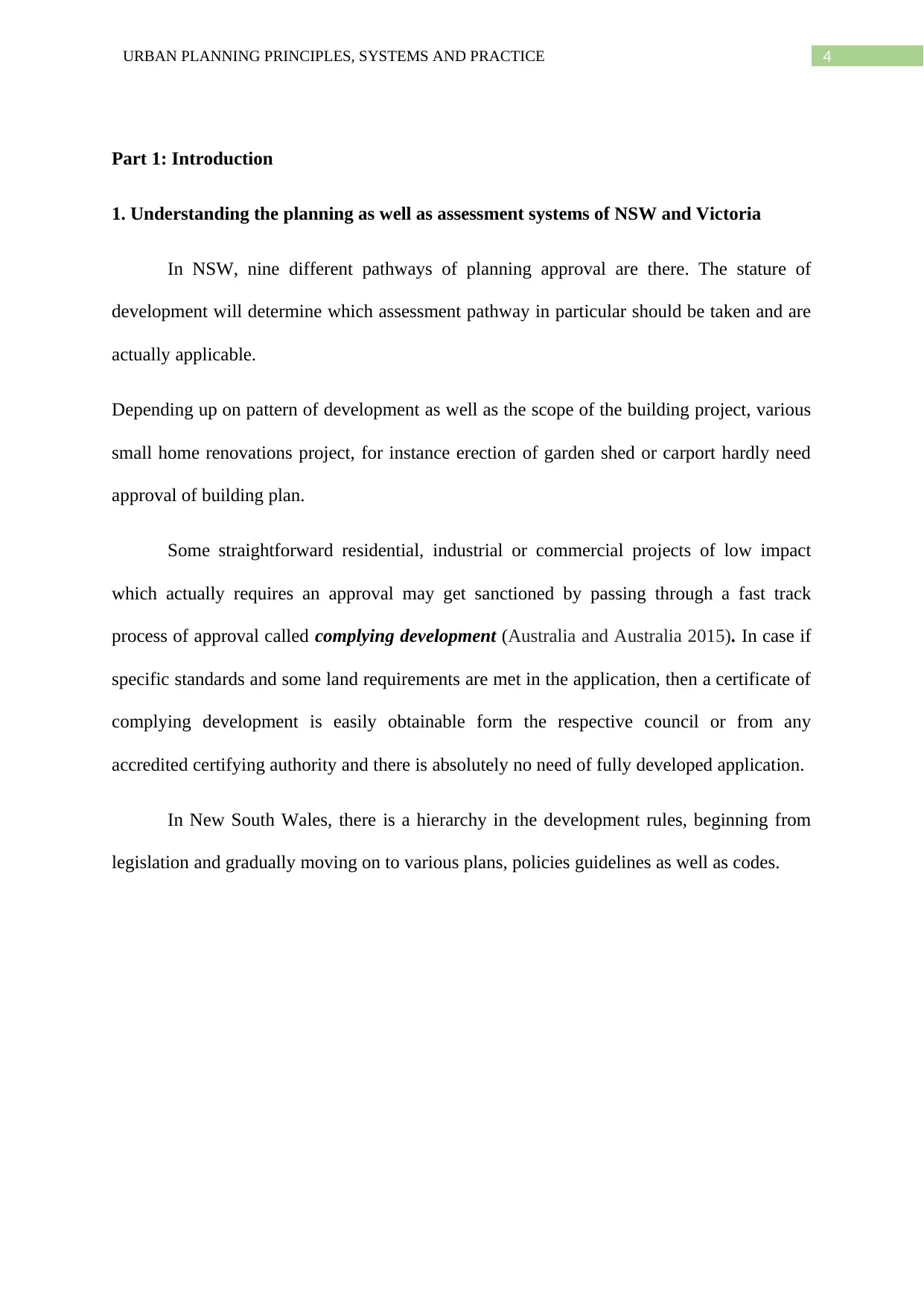
4URBAN PLANNING PRINCIPLES, SYSTEMS AND PRACTICE
Part 1: Introduction
1. Understanding the planning as well as assessment systems of NSW and Victoria
In NSW, nine different pathways of planning approval are there. The stature of
development will determine which assessment pathway in particular should be taken and are
actually applicable.
Depending up on pattern of development as well as the scope of the building project, various
small home renovations project, for instance erection of garden shed or carport hardly need
approval of building plan.
Some straightforward residential, industrial or commercial projects of low impact
which actually requires an approval may get sanctioned by passing through a fast track
process of approval called complying development (Australia and Australia 2015). In case if
specific standards and some land requirements are met in the application, then a certificate of
complying development is easily obtainable form the respective council or from any
accredited certifying authority and there is absolutely no need of fully developed application.
In New South Wales, there is a hierarchy in the development rules, beginning from
legislation and gradually moving on to various plans, policies guidelines as well as codes.
Part 1: Introduction
1. Understanding the planning as well as assessment systems of NSW and Victoria
In NSW, nine different pathways of planning approval are there. The stature of
development will determine which assessment pathway in particular should be taken and are
actually applicable.
Depending up on pattern of development as well as the scope of the building project, various
small home renovations project, for instance erection of garden shed or carport hardly need
approval of building plan.
Some straightforward residential, industrial or commercial projects of low impact
which actually requires an approval may get sanctioned by passing through a fast track
process of approval called complying development (Australia and Australia 2015). In case if
specific standards and some land requirements are met in the application, then a certificate of
complying development is easily obtainable form the respective council or from any
accredited certifying authority and there is absolutely no need of fully developed application.
In New South Wales, there is a hierarchy in the development rules, beginning from
legislation and gradually moving on to various plans, policies guidelines as well as codes.
Paraphrase This Document
Need a fresh take? Get an instant paraphrase of this document with our AI Paraphraser
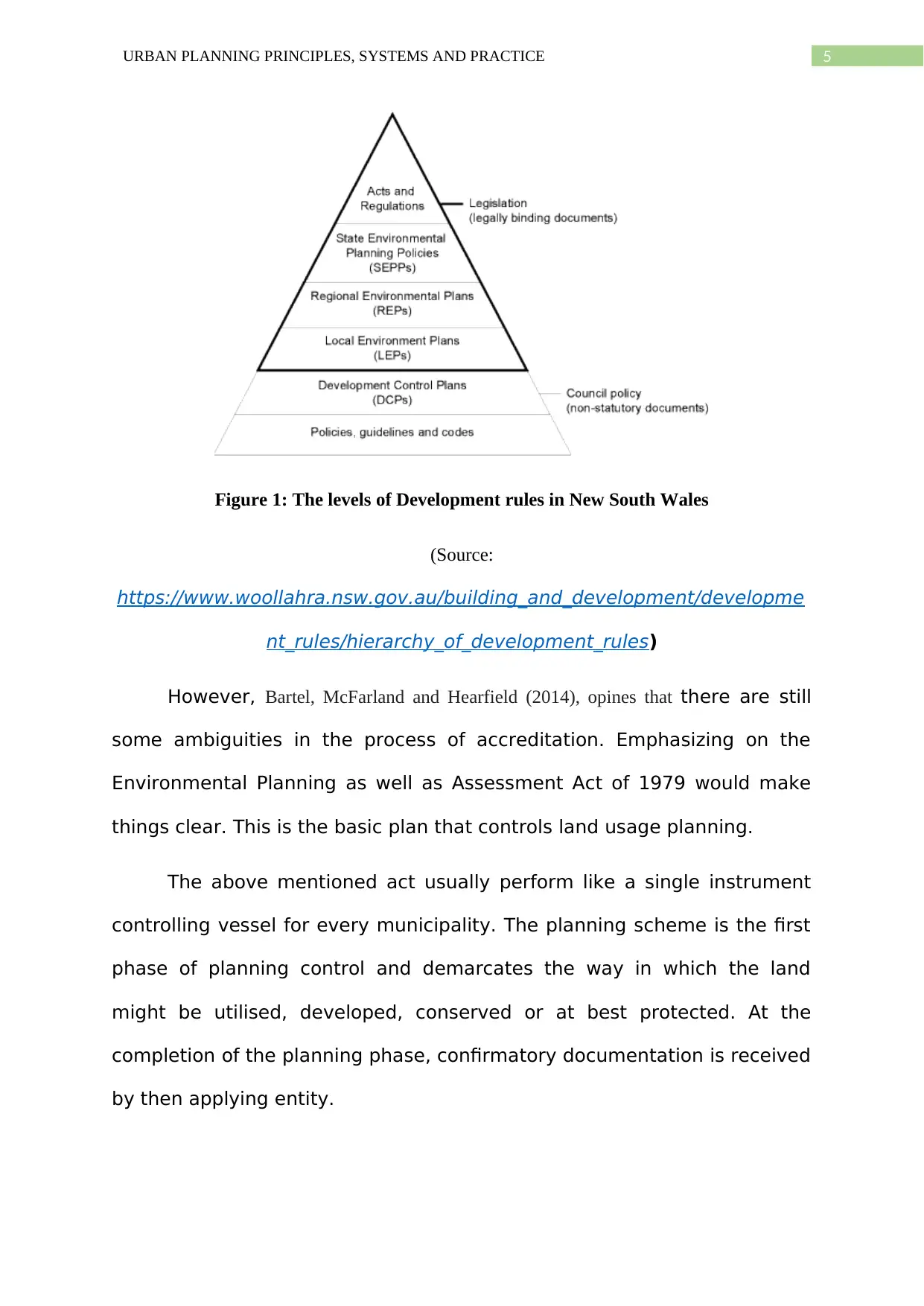
5URBAN PLANNING PRINCIPLES, SYSTEMS AND PRACTICE
Figure 1: The levels of Development rules in New South Wales
(Source:
https://www.woollahra.nsw.gov.au/building_and_development/developme
nt_rules/hierarchy_of_development_rules)
However, Bartel, McFarland and Hearfield (2014), opines that there are still
some ambiguities in the process of accreditation. Emphasizing on the
Environmental Planning as well as Assessment Act of 1979 would make
things clear. This is the basic plan that controls land usage planning.
The above mentioned act usually perform like a single instrument
controlling vessel for every municipality. The planning scheme is the first
phase of planning control and demarcates the way in which the land
might be utilised, developed, conserved or at best protected. At the
completion of the planning phase, confirmatory documentation is received
by then applying entity.
Figure 1: The levels of Development rules in New South Wales
(Source:
https://www.woollahra.nsw.gov.au/building_and_development/developme
nt_rules/hierarchy_of_development_rules)
However, Bartel, McFarland and Hearfield (2014), opines that there are still
some ambiguities in the process of accreditation. Emphasizing on the
Environmental Planning as well as Assessment Act of 1979 would make
things clear. This is the basic plan that controls land usage planning.
The above mentioned act usually perform like a single instrument
controlling vessel for every municipality. The planning scheme is the first
phase of planning control and demarcates the way in which the land
might be utilised, developed, conserved or at best protected. At the
completion of the planning phase, confirmatory documentation is received
by then applying entity.
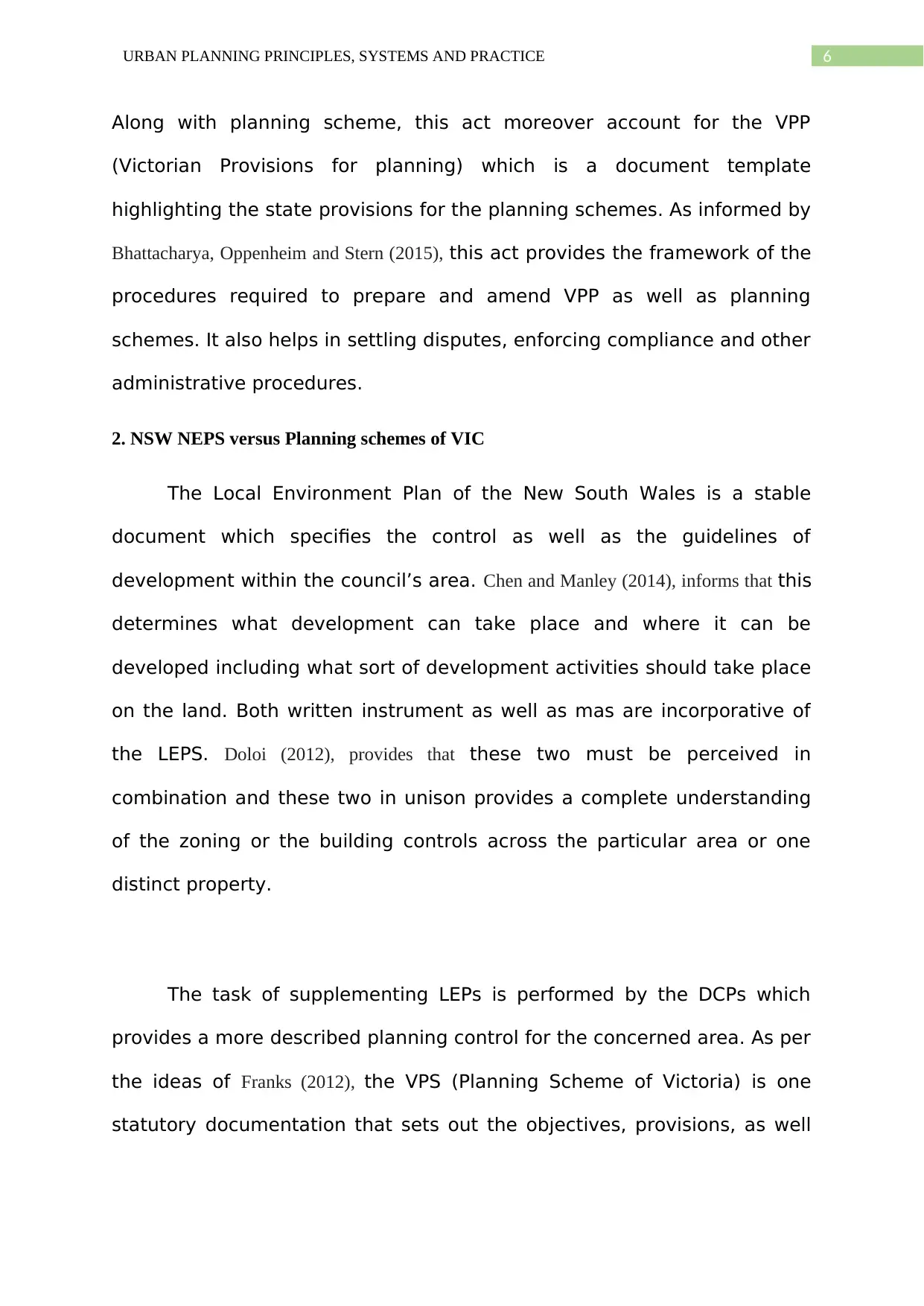
6URBAN PLANNING PRINCIPLES, SYSTEMS AND PRACTICE
Along with planning scheme, this act moreover account for the VPP
(Victorian Provisions for planning) which is a document template
highlighting the state provisions for the planning schemes. As informed by
Bhattacharya, Oppenheim and Stern (2015), this act provides the framework of the
procedures required to prepare and amend VPP as well as planning
schemes. It also helps in settling disputes, enforcing compliance and other
administrative procedures.
2. NSW NEPS versus Planning schemes of VIC
The Local Environment Plan of the New South Wales is a stable
document which specifies the control as well as the guidelines of
development within the council’s area. Chen and Manley (2014), informs that this
determines what development can take place and where it can be
developed including what sort of development activities should take place
on the land. Both written instrument as well as mas are incorporative of
the LEPS. Doloi (2012), provides that these two must be perceived in
combination and these two in unison provides a complete understanding
of the zoning or the building controls across the particular area or one
distinct property.
The task of supplementing LEPs is performed by the DCPs which
provides a more described planning control for the concerned area. As per
the ideas of Franks (2012), the VPS (Planning Scheme of Victoria) is one
statutory documentation that sets out the objectives, provisions, as well
Along with planning scheme, this act moreover account for the VPP
(Victorian Provisions for planning) which is a document template
highlighting the state provisions for the planning schemes. As informed by
Bhattacharya, Oppenheim and Stern (2015), this act provides the framework of the
procedures required to prepare and amend VPP as well as planning
schemes. It also helps in settling disputes, enforcing compliance and other
administrative procedures.
2. NSW NEPS versus Planning schemes of VIC
The Local Environment Plan of the New South Wales is a stable
document which specifies the control as well as the guidelines of
development within the council’s area. Chen and Manley (2014), informs that this
determines what development can take place and where it can be
developed including what sort of development activities should take place
on the land. Both written instrument as well as mas are incorporative of
the LEPS. Doloi (2012), provides that these two must be perceived in
combination and these two in unison provides a complete understanding
of the zoning or the building controls across the particular area or one
distinct property.
The task of supplementing LEPs is performed by the DCPs which
provides a more described planning control for the concerned area. As per
the ideas of Franks (2012), the VPS (Planning Scheme of Victoria) is one
statutory documentation that sets out the objectives, provisions, as well
⊘ This is a preview!⊘
Do you want full access?
Subscribe today to unlock all pages.

Trusted by 1+ million students worldwide
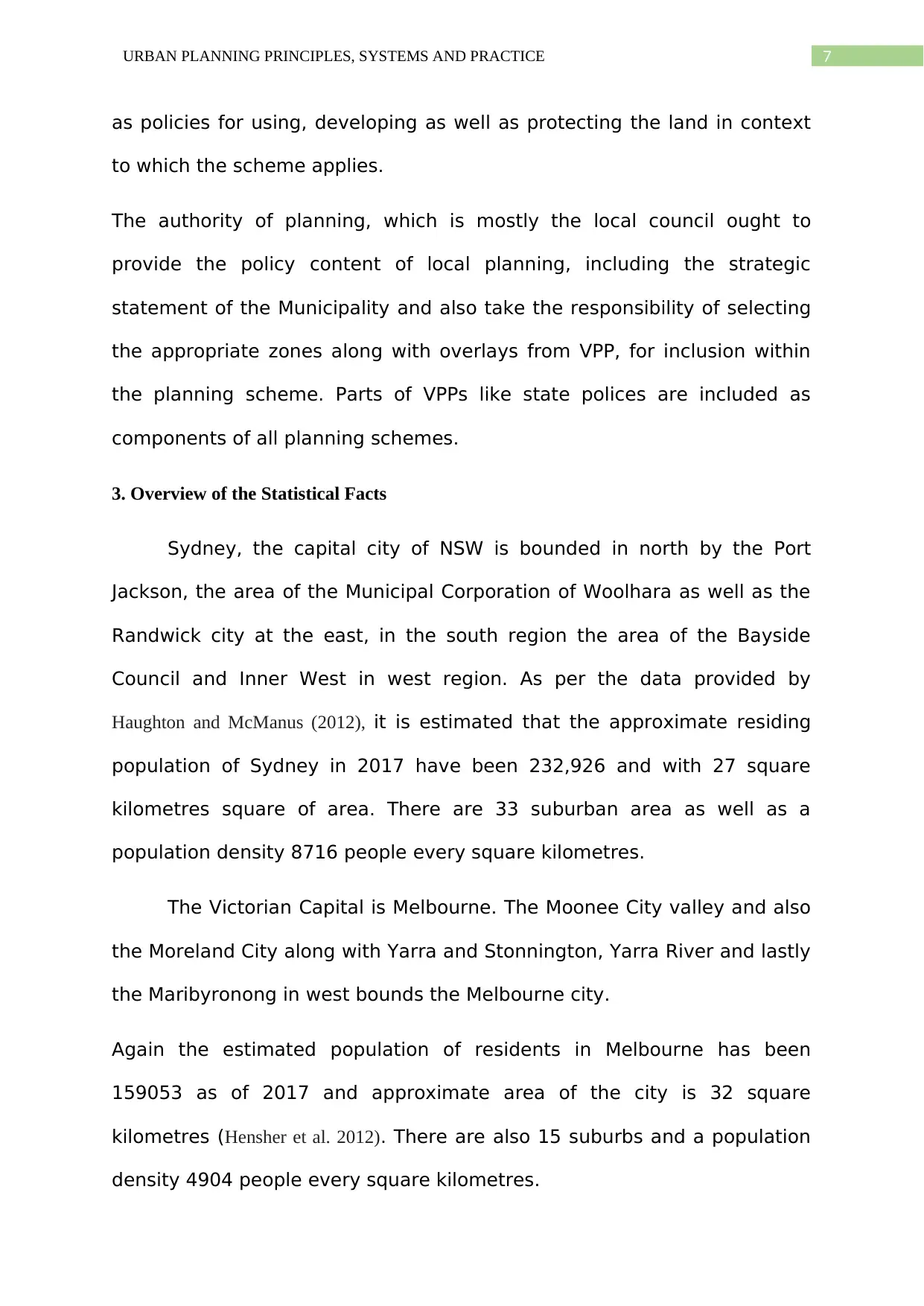
7URBAN PLANNING PRINCIPLES, SYSTEMS AND PRACTICE
as policies for using, developing as well as protecting the land in context
to which the scheme applies.
The authority of planning, which is mostly the local council ought to
provide the policy content of local planning, including the strategic
statement of the Municipality and also take the responsibility of selecting
the appropriate zones along with overlays from VPP, for inclusion within
the planning scheme. Parts of VPPs like state polices are included as
components of all planning schemes.
3. Overview of the Statistical Facts
Sydney, the capital city of NSW is bounded in north by the Port
Jackson, the area of the Municipal Corporation of Woolhara as well as the
Randwick city at the east, in the south region the area of the Bayside
Council and Inner West in west region. As per the data provided by
Haughton and McManus (2012), it is estimated that the approximate residing
population of Sydney in 2017 have been 232,926 and with 27 square
kilometres square of area. There are 33 suburban area as well as a
population density 8716 people every square kilometres.
The Victorian Capital is Melbourne. The Moonee City valley and also
the Moreland City along with Yarra and Stonnington, Yarra River and lastly
the Maribyronong in west bounds the Melbourne city.
Again the estimated population of residents in Melbourne has been
159053 as of 2017 and approximate area of the city is 32 square
kilometres (Hensher et al. 2012). There are also 15 suburbs and a population
density 4904 people every square kilometres.
as policies for using, developing as well as protecting the land in context
to which the scheme applies.
The authority of planning, which is mostly the local council ought to
provide the policy content of local planning, including the strategic
statement of the Municipality and also take the responsibility of selecting
the appropriate zones along with overlays from VPP, for inclusion within
the planning scheme. Parts of VPPs like state polices are included as
components of all planning schemes.
3. Overview of the Statistical Facts
Sydney, the capital city of NSW is bounded in north by the Port
Jackson, the area of the Municipal Corporation of Woolhara as well as the
Randwick city at the east, in the south region the area of the Bayside
Council and Inner West in west region. As per the data provided by
Haughton and McManus (2012), it is estimated that the approximate residing
population of Sydney in 2017 have been 232,926 and with 27 square
kilometres square of area. There are 33 suburban area as well as a
population density 8716 people every square kilometres.
The Victorian Capital is Melbourne. The Moonee City valley and also
the Moreland City along with Yarra and Stonnington, Yarra River and lastly
the Maribyronong in west bounds the Melbourne city.
Again the estimated population of residents in Melbourne has been
159053 as of 2017 and approximate area of the city is 32 square
kilometres (Hensher et al. 2012). There are also 15 suburbs and a population
density 4904 people every square kilometres.
Paraphrase This Document
Need a fresh take? Get an instant paraphrase of this document with our AI Paraphraser

8URBAN PLANNING PRINCIPLES, SYSTEMS AND PRACTICE
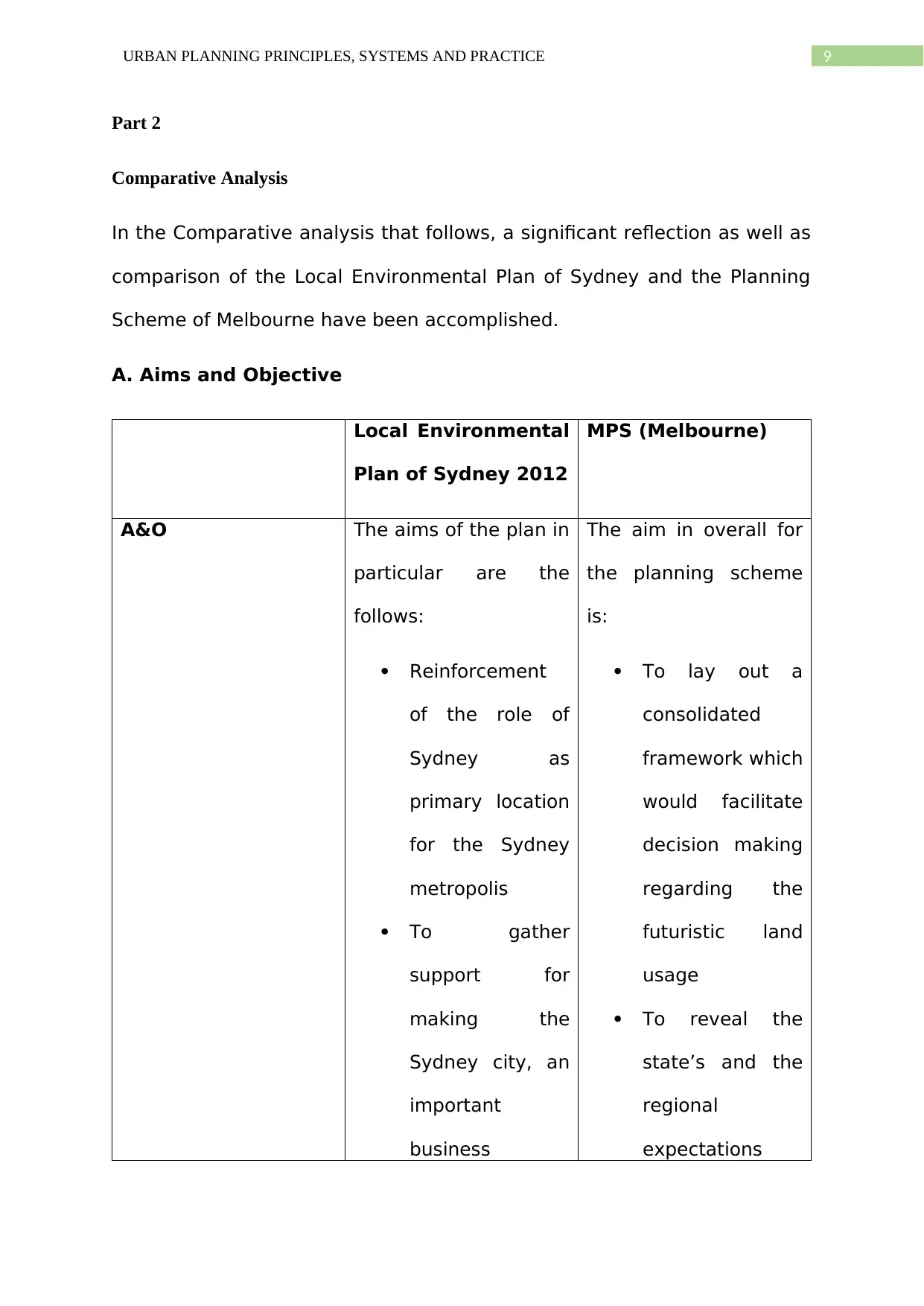
9URBAN PLANNING PRINCIPLES, SYSTEMS AND PRACTICE
Part 2
Comparative Analysis
In the Comparative analysis that follows, a significant reflection as well as
comparison of the Local Environmental Plan of Sydney and the Planning
Scheme of Melbourne have been accomplished.
A. Aims and Objective
Local Environmental
Plan of Sydney 2012
MPS (Melbourne)
A&O The aims of the plan in
particular are the
follows:
Reinforcement
of the role of
Sydney as
primary location
for the Sydney
metropolis
To gather
support for
making the
Sydney city, an
important
business
The aim in overall for
the planning scheme
is:
To lay out a
consolidated
framework which
would facilitate
decision making
regarding the
futuristic land
usage
To reveal the
state’s and the
regional
expectations
Part 2
Comparative Analysis
In the Comparative analysis that follows, a significant reflection as well as
comparison of the Local Environmental Plan of Sydney and the Planning
Scheme of Melbourne have been accomplished.
A. Aims and Objective
Local Environmental
Plan of Sydney 2012
MPS (Melbourne)
A&O The aims of the plan in
particular are the
follows:
Reinforcement
of the role of
Sydney as
primary location
for the Sydney
metropolis
To gather
support for
making the
Sydney city, an
important
business
The aim in overall for
the planning scheme
is:
To lay out a
consolidated
framework which
would facilitate
decision making
regarding the
futuristic land
usage
To reveal the
state’s and the
regional
expectations
⊘ This is a preview!⊘
Do you want full access?
Subscribe today to unlock all pages.

Trusted by 1+ million students worldwide
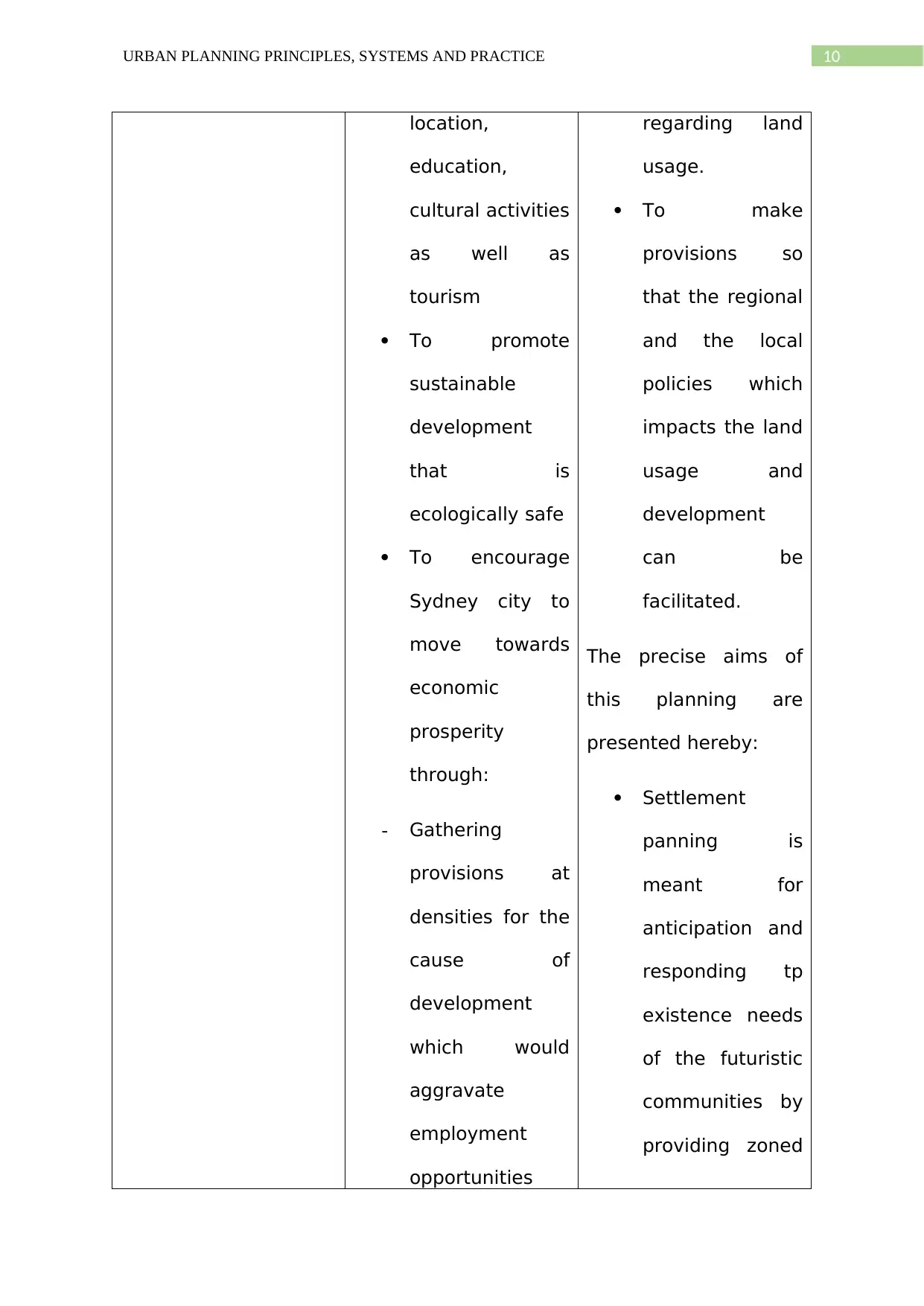
10URBAN PLANNING PRINCIPLES, SYSTEMS AND PRACTICE
location,
education,
cultural activities
as well as
tourism
To promote
sustainable
development
that is
ecologically safe
To encourage
Sydney city to
move towards
economic
prosperity
through:
- Gathering
provisions at
densities for the
cause of
development
which would
aggravate
employment
opportunities
regarding land
usage.
To make
provisions so
that the regional
and the local
policies which
impacts the land
usage and
development
can be
facilitated.
The precise aims of
this planning are
presented hereby:
Settlement
panning is
meant for
anticipation and
responding tp
existence needs
of the futuristic
communities by
providing zoned
location,
education,
cultural activities
as well as
tourism
To promote
sustainable
development
that is
ecologically safe
To encourage
Sydney city to
move towards
economic
prosperity
through:
- Gathering
provisions at
densities for the
cause of
development
which would
aggravate
employment
opportunities
regarding land
usage.
To make
provisions so
that the regional
and the local
policies which
impacts the land
usage and
development
can be
facilitated.
The precise aims of
this planning are
presented hereby:
Settlement
panning is
meant for
anticipation and
responding tp
existence needs
of the futuristic
communities by
providing zoned
Paraphrase This Document
Need a fresh take? Get an instant paraphrase of this document with our AI Paraphraser

11URBAN PLANNING PRINCIPLES, SYSTEMS AND PRACTICE
- Retaining as well
as increasing
use of land meat
for educational
purposes.
To provide for
the growing of a
diverse and big
population in
Sydney city by
making
provisions of
appropriate and
affordable
housing.
To enforce a
series of various
services as well
as infrastructure
which meets the
requirement of
workers, residing
people and the
visitors as well.
To make sure
as well as
serviced land
areas for the
needs like
housing,
recreation,
commercial
usage,
community
facilities and so
on.
To save the
greenery in
Melbourne from
getting affected
from housing
developments
To make sure
that sufficient
land supply is
there for the
main purposes
like residence,
retail business,
recreation,
- Retaining as well
as increasing
use of land meat
for educational
purposes.
To provide for
the growing of a
diverse and big
population in
Sydney city by
making
provisions of
appropriate and
affordable
housing.
To enforce a
series of various
services as well
as infrastructure
which meets the
requirement of
workers, residing
people and the
visitors as well.
To make sure
as well as
serviced land
areas for the
needs like
housing,
recreation,
commercial
usage,
community
facilities and so
on.
To save the
greenery in
Melbourne from
getting affected
from housing
developments
To make sure
that sufficient
land supply is
there for the
main purposes
like residence,
retail business,
recreation,
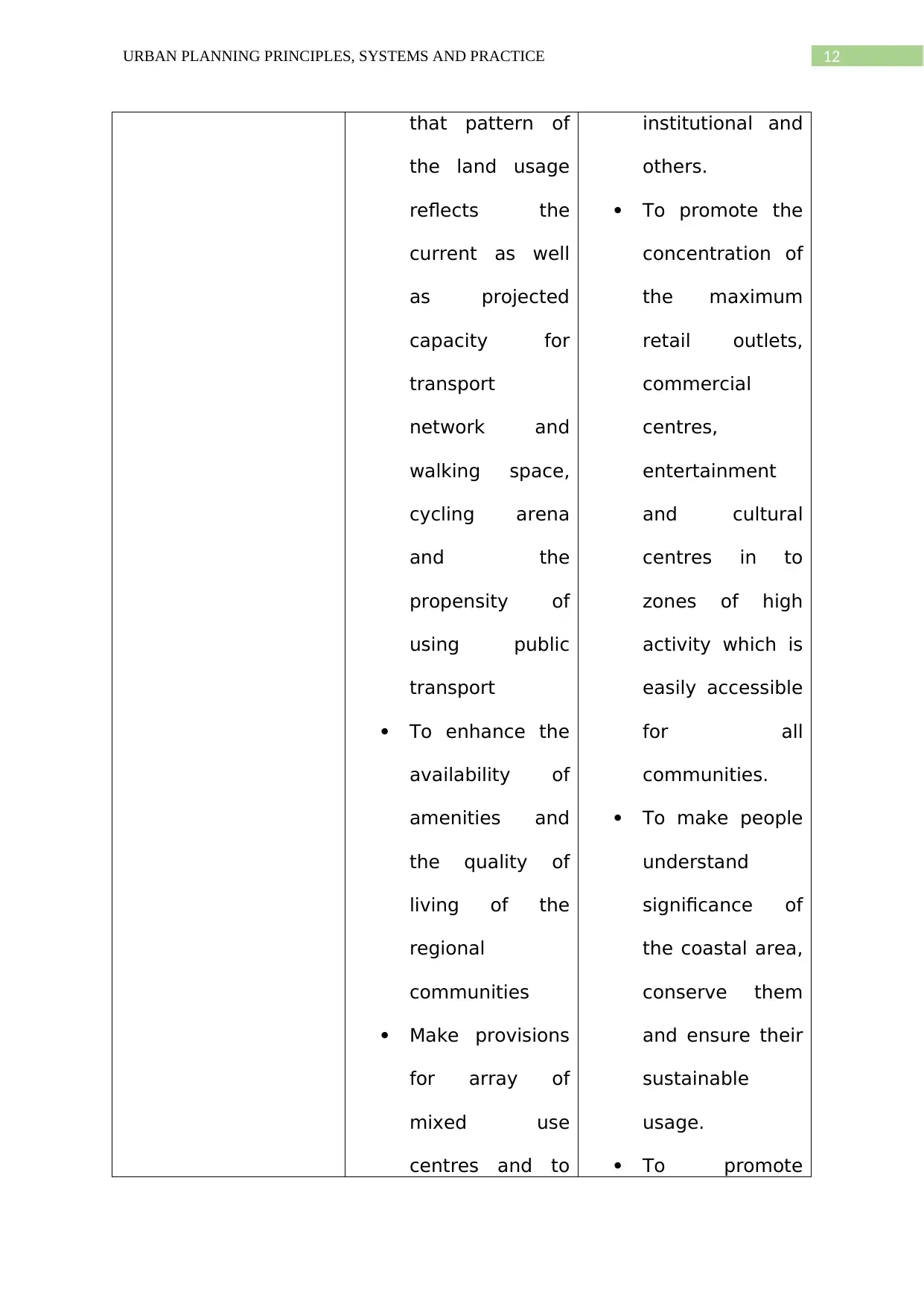
12URBAN PLANNING PRINCIPLES, SYSTEMS AND PRACTICE
that pattern of
the land usage
reflects the
current as well
as projected
capacity for
transport
network and
walking space,
cycling arena
and the
propensity of
using public
transport
To enhance the
availability of
amenities and
the quality of
living of the
regional
communities
Make provisions
for array of
mixed use
centres and to
institutional and
others.
To promote the
concentration of
the maximum
retail outlets,
commercial
centres,
entertainment
and cultural
centres in to
zones of high
activity which is
easily accessible
for all
communities.
To make people
understand
significance of
the coastal area,
conserve them
and ensure their
sustainable
usage.
To promote
that pattern of
the land usage
reflects the
current as well
as projected
capacity for
transport
network and
walking space,
cycling arena
and the
propensity of
using public
transport
To enhance the
availability of
amenities and
the quality of
living of the
regional
communities
Make provisions
for array of
mixed use
centres and to
institutional and
others.
To promote the
concentration of
the maximum
retail outlets,
commercial
centres,
entertainment
and cultural
centres in to
zones of high
activity which is
easily accessible
for all
communities.
To make people
understand
significance of
the coastal area,
conserve them
and ensure their
sustainable
usage.
To promote
⊘ This is a preview!⊘
Do you want full access?
Subscribe today to unlock all pages.

Trusted by 1+ million students worldwide
1 out of 27
Related Documents
Your All-in-One AI-Powered Toolkit for Academic Success.
+13062052269
info@desklib.com
Available 24*7 on WhatsApp / Email
![[object Object]](/_next/static/media/star-bottom.7253800d.svg)
Unlock your academic potential
Copyright © 2020–2025 A2Z Services. All Rights Reserved. Developed and managed by ZUCOL.





